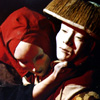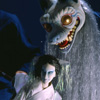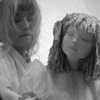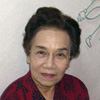 |
|
|
|
|
 |
 |
 |
 |
March 7th [Wed] 16:30-18:30 / Tokyo International Forum Hall B7-1
Director: KATO Akiko [puppet-theatre researcher] |
 |
| In the 1960s, the concept of puppet theatre drastically changed especially in Europe. The stage - previously occupied only by puppets - was extended, and manipulators began to perform alongside. The concept of puppetry itself also changed. In addition to human-formed puppets, materials, sounds, lights, and performers also became dramatic elements within their own right. This was the beginning of “object theatre.” Perhaps, however, this corresponds to Japanese animism, which until the modern age preached that every object has its own spirit. The kugutsu-shis of our time performing at this showcase - that is, traveling puppet players who are said to be the predecessors of bunraku- have each developed their own methodology, narrative and material worlds. |
|
 |
 |
 |
DONDORO Theatre
Now based in Inadani in Shinshu area, Dondoro Theatre was founded in Tokyo in 1974. The puppetry style consists of distinctive life-size puppets and masks made by director OKAMOTO Hoichi with the manipulator also appearing on stage. Praised locally and abroad for introducing an “original and new expression based on Japanese tradition”, Dondoro Theatre has been invited to various festivals, most notably in Europe.
|
|
 |
 |
 |
KAWASEMI-ZA
Founded by YAMAMOTO Yoshiya, who studied with Takeda Ningyo-Za, a traditional string-puppet theatre group. Since then, Yamamoto has designed and manufactured all the puppets himself. Actress MASUMURA Izumi joined in 1994. Their innovative performances are highly acknowledged both domestically and internationally for their puppetry designs, richness of expression, creativity, and artistic quality. In 2005, they performed Where Spirits and Fairies Dwell, directed by TAKAHATA Isao, in Italy and Edinburgh.
|
|
 |

© Tominaga Mitsuaki |
 |
KUROTANI Miyako
Began activities as a puppeteer in 1974. Founded puppet company Guinneko Shokai in 1977, which lasted until 2002. After studying in Czechoslovakia, she shifted to solo performances from 1995 onwards. For Kurotani, “puppet theater is an expression that consists of puppets and puppeteers,” and she sees puppetry's essence in the horizontal relation between herself and puppets (matters) and the liberation of “these matters' matters.” Currently, she defines her own expression as “genre: Gray = The Grotesque with obeying objects and selfish bodies or with selfish objects and obeying bodies.”
|
|
 |
 |
 |
·Director:KATO Akiko


Joined Ningyo-Za in 1955 and worked until 1963. Since then, she has freelanced managing decor, mise en scene, and scripts in various puppet-theatre companies. In 1962, she studied European puppet theatre, focusing on East-Europe, at the Theatre Faculty of Academy of Performing Arts in Prague. Among her books are Ningyo no Kuni no Gulliver san (Mr. Gulliver in the Country of Puppets) and translation of Henryk Jurkowski's Aspects of Puppet Theatre. Kato is also an advisor to Nihon Engeki Kyoiku Renmei [Japan Theatre Education Association], and the organizer of Ningyo Geki wo Yomitoku Kai [Meeting for Interpretation of Puppet Theatre].
|
|
|
|
|
|
|
|
|
 |
